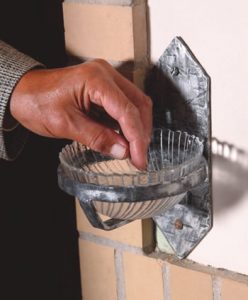Signing yourself with Holy Water
Having written about the Triduum in the last issue, I was asked why, during that time, the Holy Water stoups (or fonts) by the Church doors are left empty. This has had me thinking about why we usually cross ourselves with holy water on entering and leaving a Catholic Church.
Like many things in religion, crossing oneself is something that is done habitually rather than thought much about. The gesture does not have a single simple meaning. It is a bodily action, a ritual, a sacramental, and when it is combined with entering a leaving a sacred space there are a lot of things going on.
Firstly making the sign of the cross is an ancient Christian custom. St Ephrem of Syria, writing in the fourth century, had this advice:
‘Mark all your actions with the sign of the life-giving Cross. Do not go out from the door of your house till you have signed yourself with the Cross. Do not neglect that sign whether in eating or drinking or going to sleep, or in the home or going on a journey. There is no habit to be compared with it. Let it be a protecting wall round all your conduct, and teach it to your children that they may earnestly learn the custom.’
We cross ourselves when beginning and ending prayer. The gesture is obviously intended to recall the saving death and resurrection of Jesus. We sometimes accompany the gesture with the Trinitarian formula “In the name of the Father and of the Son and of the Holy Spirit” which is how the Risen Christ instructed the Apostles to baptize all nations. (Matthew 28:19)
 The custom is thus linked with the Paschal mystery and the invocation of the Trinity; no wonder therefore that Ephrem saw it as “protective” – it is intended to ward off harm, to keep evil at bay. He sees the regular crossing of oneself as the best of habits. That reminds me of a Maltese friend whom I heard accurately described as “So Catholic that she makes the sign of the cross on lighting a cigarette.” Perhaps the virtue of her good habit may have lessened the harm of the bad habit of smoking.
The custom is thus linked with the Paschal mystery and the invocation of the Trinity; no wonder therefore that Ephrem saw it as “protective” – it is intended to ward off harm, to keep evil at bay. He sees the regular crossing of oneself as the best of habits. That reminds me of a Maltese friend whom I heard accurately described as “So Catholic that she makes the sign of the cross on lighting a cigarette.” Perhaps the virtue of her good habit may have lessened the harm of the bad habit of smoking.
Entering a church we are stepping out of the mundane world into a sacred space. When we cross the threshold we are shifting from one reality to another. Anthropologists view such transitions into and out of a sacred setting as particularly fraught. It is very appropriate that a special custom of making the sign of the cross with blessed water developed in Christianity for this transition. It may have originated from the Jewish custom of washings for purification, or the liturgical use of the asperges in the penitential rite. In favour of the latter is the fact that our custom is not a washing of the hands but a blessing of the self.
The use of the Trinitarian formula and water certainly point to a link with baptism. We entered the Church through the sacrament of baptism, and as we physically enter a church, our signing of ourselves is a reminder of that baptism. Baptism is the essential step on the path to sharing in the Eucharist. As we assemble for mass, and prepare to receive the Lord, it is fitting that we bless ourselves in recollection of the first sacrament we received.
This brings us back to the question I was asked: “Why in many churches on Good Friday and Holy Saturday are the holy water fonts emptied?” The practice is connected with waiting for the blessing of the Easter Water and the fact that on those two days the Church does not celebrate the Eucharist. I suspect that another part of the reason is to interrupt a habitual action so that for a moment we think about why we do it.

 Entries(RSS)
Entries(RSS)